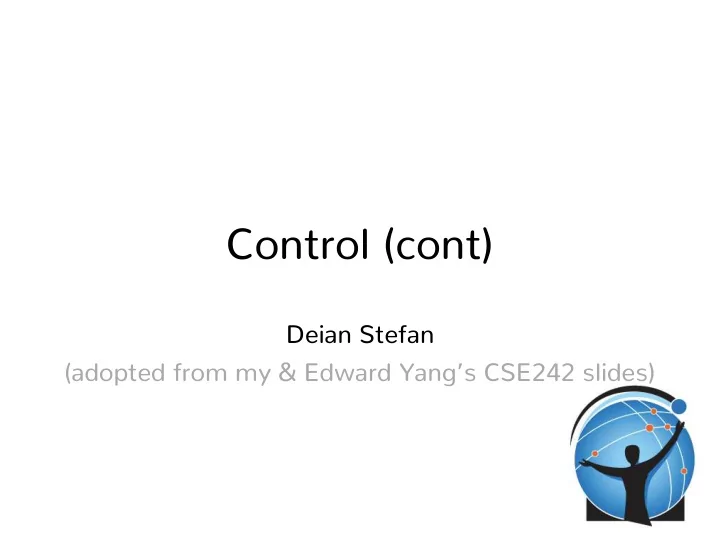

Control (cont) Deian Stefan (adopted from my & Edward Yang’s CSE242 slides)
Continuations are implicit in your code • Code you write implicitly manages the future (continuation) of its computation • Consider: ( 2*x + 1/y ) * 2 A. Multiply 2 and x B. Divide 1 by y current computation C. Add A and B rest of the program, current continuation D. Multiply C and 2
Continuations are implicit in your code • Code you write implicitly manages the future (continuation) of its computation • Consider: ( 2*x + 1/y ) * 2 A. Multiply 2 and x B. Divide 1 by y let before = 2*x; let cont = curResult => C. Add A and B (before + curResult) * 2; cont(1/y) D. Multiply C and 2
Node.js example • Implicit continuation: const data = fs.readFileSync(‘myfile.txt’) console.log(data); processData(data); • Explicit continuation fs.readFile(‘myfile.txt', callback) function callback (err, data) { console.log(data); processData(data); });
Continuation passing style (CPS) • Some languages let you get your hands on the current continuation ➤ call/cc (call with current continuation) is used to call a function and give it the current continuation ➤ Why is this powerful? A: let’s some inner function bail out and continue program by calling continuation • Most languages don’t let you get your hands on the current continuation: transform your code to CPS!
Continuation passing style • Why do we want to do this? ➤ Makes control flow explicit: no return! ➤ Makes evaluation order explicit • So? Why should you care about this? ➤ IR of a number of languages ➤ Turns function returns, exceptions, etc.: single jmp instruction! Can get rid of runtime stack!
To CPS, by example cc is a function (the current continuation) function zero() { function zero(cc) { return 0; cc(0); } } continue execution by calling cc
To CPS, by example function fact(n) { function fact(n, cc) { if (n == 0) { if (n == 0) { return 1; cc(1); } else { } else { return n* fact (n-1); fact(n-1, r => cc(n*r)); } } } }
To CPS, by example function fact(n, cc) { if (n == 0) { cc(1); } else { fact(n-1, r => cc(n*r)); } } fact(3, id) -> fact(2, r A => id(3*r A )) -> fact(1, r b => (r A => id(3*r A ))(2*r b )) -> fact(0, r c => (r b => (r A => id(3*r A ))(2*r b) )(1*r c )) -> (r c => (r b => (r A => id(3*r A ))(2*r b) )(1*r c ))(0) -> (r b => (r A => id(3*r A ))(2*r b) )(1*0) -> (r A => id(3*r A ))(2*1*0) -> id(3*2*1*0)
To CPS, by example function twice(f, x, cc) { function twice(f, x) { f(x, r => f(r, cc)); return f(f(x)); } } function twice(f, g, x, cc) { function cmp(f, g, x) { g(x, r => f(r, cc)); return f(g(x)); } }
To CPS, by example function twice(f, x) { function twice(f, x, cc) { let r = f(x); f(x, r => f(r, cc)); return f(r); } }
To CPS, the rules • Function decls take extra argument: the continuation ➤ function (x) { ➡ function (x, cc) { • There are no more returns! Call continuation instead ➤ return x; ➡ cc(x); • Lift nested function calls out of subexpressions ➤ let r = g(x); g(x, r => { stmt 1 ➡ stmt 1 ; stmt 2 stmt 2 })
Why is this useful? • Makes control flow explicit ➤ Compilers like this form since they can optimize code ➤ One technique: tail-call optimization • Multithreaded programming • Event based programming such as GUIs
Continuations are extremely powerful • Generalization of goto! • Can implement control flow constructs using continuations • How do we do if statements? • How do we do exceptions?
Exceptions w/ continuations function f() { throw “w00t”; } try { f(); console.log(“no way!”); } catch (e) { console.log(e); } console.log(“cse130 is lit”);
Exceptions w/ continuations 1. function f() { throw “w00t”; } 2. current cont = line 9 3. try { 4. f(); 5. console.log(“no way!”); 6. } catch (e) { 7. console.log(e); 8. } 9. console.log(“cse130 is lit”);
Exceptions w/ continuations 1. function f() { throw “w00t”; } 2. success cont = 3. try { line 5;previous cc = lines 5;9 4. f(); 5. console.log(“no way!”); fail cont = lines 6-8;previous cc = lines 6-9 6. } catch (e) { 7. console.log(e); 8. } 9. console.log(“cse130 is lit”);
Control • Structured programming continuations • Procedural abstraction structured programming block goto procedural abstraction • Exceptions control flow exceptions • Continuations
Fin: the great ideas Expressive power (say more with less) First-class functions Pattern matching Type inference Exception handling Monads Continuations Reliability and reuse Type classes Type polymorphism Objects & inheritance Modules
Recommend
More recommend